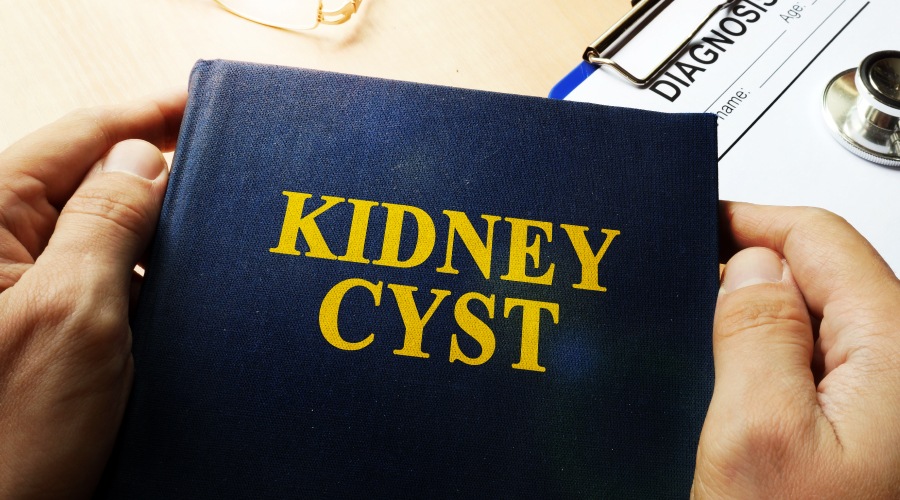

People of all ages can be affected by kidney cysts. They are fluid-filled sacs that can develop in the kidneys. While most cysts are benign and symptomless, some might create problems. If left untreated, these cysts can grow larger, potentially causing pain, infections, high blood pressure, or even impair kidney function. Timely treatment is crucial to avoid complications like kidney damage or chronic kidney disease, which can significantly impact an individual’s quality of life.
In this comprehensive guide, we’ll explore the symptoms, causes, types, and treatment options for kidney cysts.
Kidney Cyst Symptoms
Usually, kidney cysts don’t show any symptoms. Most often, they are discovered by a doctor during an ultrasound or computerised tomography (CT) scan that is performed for another purpose. Some common kidney cyst symptoms are:
- Chills, fever, or other infection-related symptoms
- Blood in urine
- Reduced kidney function
- Blocked blood or urine flow through kidneys
- High blood pressure
- Urinating more often than normal
- Dark urine
- Pain in the upper abdomen, back, or side.
Kidney cyst symptoms in females can include irregular menstruation, hypertension, back or abdominal pain, urinary changes, recurring infections, and pregnancy challenges.
Kidney Cyst Causes
A kidney cyst develops when a nephron’s tube starts to swell and fill with fluid. While the exact cause of this is unknown, researchers do know that simple cysts are not inherited—that is, they do not result from disorders acquired from one’s biological parents. However, it is believed that simple kidney cysts may occur as a result of an injury or microscopic blockages in the tubules.
Other kidney cyst causes are:
- Genetic disorder known as polycystic kidney disease
- Certain Renal diseases such as chronic kidney disease
- Renal cysts and diabetes syndromes, a rare type of diabetes that primarily affects younger people
- Multicystic dysplastic kidney disease, where a group of cysts develops during foetal development.
Types of Kidney Cysts
The common types of kidney cysts are simple, complex, or polycystic kidney disease that are explained as:
- Simple Kidney Cysts: These are usually benign (non-cancerous) and harmless. They typically do not cause symptoms until they become large. You might be unaware that you have one. Simple cysts are round, filled with fluid, and have thin walls. According to the classification scale, these fall under category I and do not require treatment.
- Complex Kidney Cysts: There is a possibility that complex kidney cysts will develop into cancer. Complex cysts require monitoring and may necessitate treatment or removal. They don’t appear like a typical cyst. Complex kidney cysts might have a thick outer wall, an uneven shape, or be solid (not filled with fluid). Compared to simple cysts, complex cysts are significantly less common. A complex cyst is classified as II, II-F, III, or IV by your provider after careful evaluation.
- Polycystic Kidney Disease: A genetic illness called polycystic kidney disease (PKD) is marked by the development of many kidney cysts, which cause the kidneys to enlarge and can eventually lead to kidney failure.
Diagnosis and Evaluation
If you visit a healthcare provider, they may proceed with the cysts’ diagnosis in the following ways:
- Imaging Tests: Kidney cysts are often revealed during ultrasounds, CT scans, and MRIs carried out for other medical reasons.
- Urine and Blood Testing: Increased levels of urea or creatinine in blood tests can indicate poor kidney health. Protein or blood might be found in the urine by urinalysis.
- Genetic Testing: Genetic testing may be carried out in some suspected cases to confirm the diagnosis of polycystic kidney disease (PKD).
Kidney Cyst Treatment Options
When you are diagnosed with cysts in your kidney, medical professionals implement the below listed methods for its treatment:
- Observation: Simple kidney cysts that do not cause signs or symptoms may not need medical attention; instead, they can be routinely checked with imaging tests.
- Pain Management: Ibuprofen or acetaminophen are over-the-counter painkillers that may help reduce kidney cyst discomfort.
- Drainage or Aspiration: Using a needle guided by ultrasound or CT imaging, large or symptomatic cysts may be drained or aspirated.
- Sclerotherapy: In order to shrink the cyst and lessen symptoms, a sclerosing agent is injected into the cyst.
- Surgery: Laparoscopic cyst decortication or partial nephrectomy are two surgical interventions that may be required in cases of big, symptomatic, or complex cysts.
Conclusion
Even though most kidney cysts are benign and symptomless, it’s important to be aware of any possible symptoms and, if required, seek medical attention. Making informed decisions regarding one’s kidney health can be assisted by having a thorough understanding of the types, causes, and available kidney cyst treatment options. If your symptoms are bothersome or persistent, speak with a healthcare provider for an accurate diagnosis and course of treatment.




